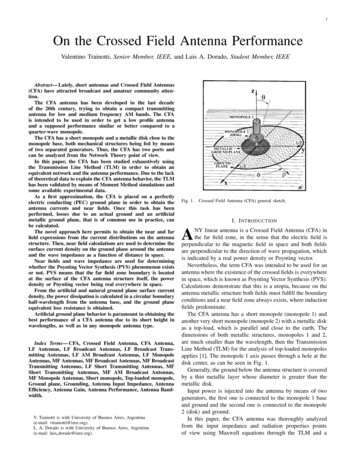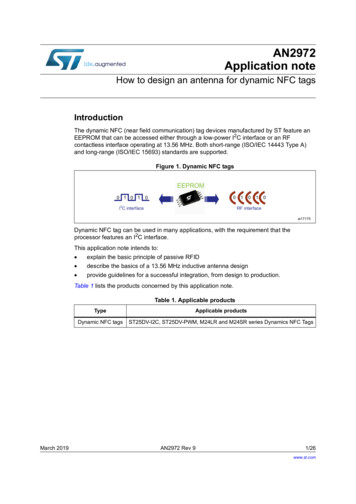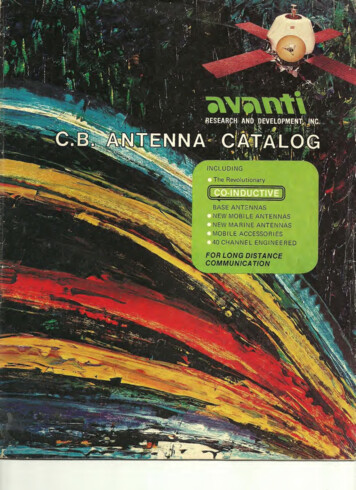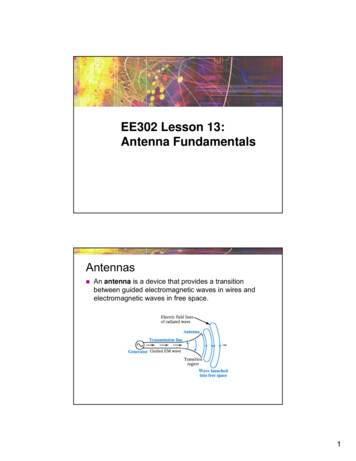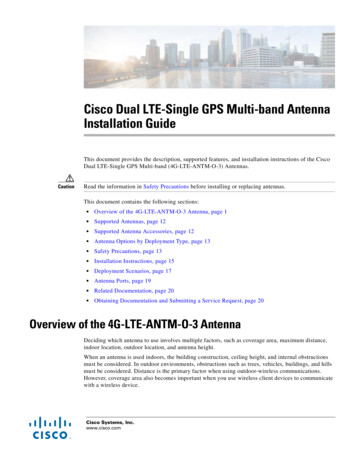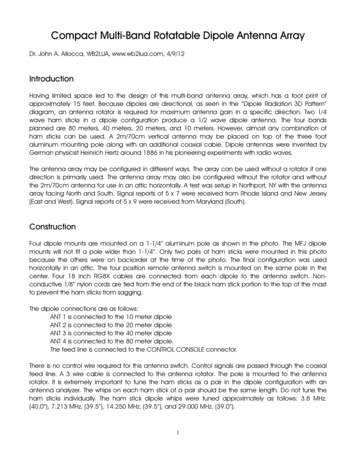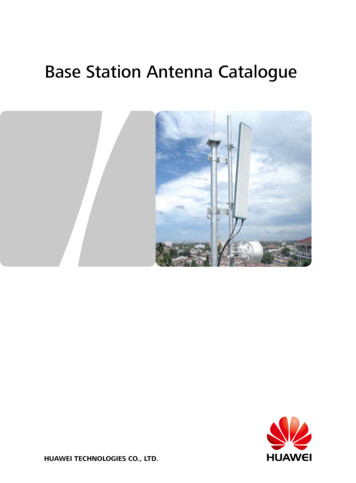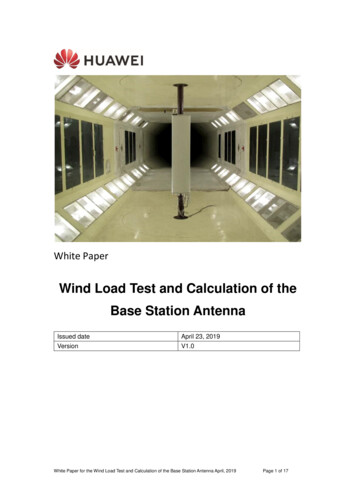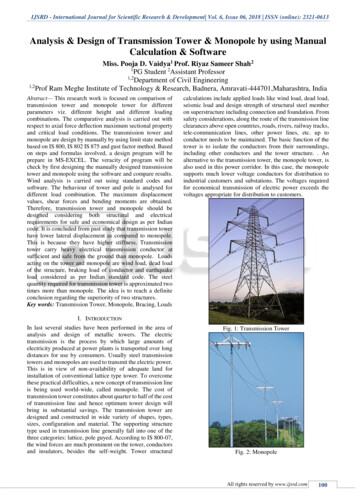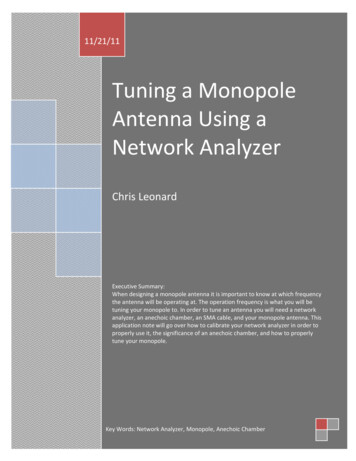
Transcription
11/21/11Tuning a MonopoleAntenna Using aNetwork AnalyzerChris LeonardExecutive Summary:When designing a monopole antenna it is important to know at which frequencythe antenna will be operating at. The operation frequency is what you will betuning your monopole to. In order to tune an antenna you will need a networkanalyzer, an anechoic chamber, an SMA cable, and your monopole antenna. Thisapplication note will go over how to calibrate your network analyzer in order toproperly use it, the significance of an anechoic chamber, and how to properlytune your monopole.Key Words: Network Analyzer, Monopole, Anechoic Chamber
Table of Context:Introduction . .3Objective . .4Getting Started . 4Anechoic Chamber . .5Designing and Tuning . 6Application . . 7References 8Page 2
Introduction:A monopole antenna is an antenna that is commonly used for its directive gain and itsradiation pattern which covers a large area. The monopole is generally made out of a wire or arod-shaped conductor. The monopole is mounted perpendicular to a ground plane formaximum radiation and directive gain. A monopole is similar to a dipole except that the otherhalf of the wire or rod is replaced with the ground plane which in turn increases the directivegain of the antenna by 3dB. There are many applications for a monopole antenna such as anantenna to broadcast for radio stations. The donut shape radiation pattern allows forbroadcasting in all directions and they are able to utilize the earth itself as an infinitely largeground plane. Another application for the antenna is communication in the GHz range with cellphones. Many cars and airplanes have a monopole as an antenna for their wirelesscommunication where it can use the body of the automobile as the ground plane.The radiation pattern of a monopole antenna can be seen below.Page 3
Objective:The objective of this document is to walk you through how to tune a monopole antenna.In order to begin the project you must first pick a frequency to design around because thedimensions of the monopole are directly related to the frequency of operation. The user musthave access to a network analyzer and it would be very helpful to have access to an anechoicchamber for more precise measurements.Getting Started:First you will need access to a vector network analyzer (VNA). Using a network analyzerallows you to measure things over a sweep of frequencies and is able to plot your gain over thesweep. Before the network analyzer can be used, it must be calibrated. The calibration is a veryimportant step in the process of using the VNA and must be done every time you use it. Inorder to calibrate the network analyzer you will need a very precise calibration kit with anopen, short, and a 50Ω terminated load. These three together will be individually attached tothe S-parameter cables on the VNA during the calibration process because they are a knownload and will be used as a reference. Here in our lab we use the Agilent 85032B Type Ncalibration kit. These connectors are highly precise and are always used with special care.If you are using an Agilent 85032 or a similar device, the calibration process will be the same.Follow the following steps to calibrate your system before you can begin taking measurementson your antenna.1. Power the Agilent 85032 network analyzer on.2. Press the Preset button to return the VNA to its base state.3. To select the frequencies that youlike to sweep through press SWEEP LIN FREQ START and then enter thefrequency that you would like tobegin the sweep at and then indicatethe units of the frequency byselecting it on the keypad. Next pressEND and then enter the ending frequency of the sweep and again selectthe units using the keypad.4. Select SWEEP and enter the number of points to plot between your linearfrequency sweep.Page 4would
5. Select CAL N 50Ω for your calibration kitselection.6. Press CAL CALIBRATE MENU S11 1 PORT toselect that you will be calibrating the S11 portand only using that one port to test.7. From the calibration kit, attach the Open to theend of the S11 port cable that you will be using.8. Press OPENS OPEN [M] this completes the opentest part of the calibration; The M indicated theconnector gender.9. Repeat Step 8 for the Short and the impedance matched Load.10. When these steps are complete, the network analyzer will be calibrated to the end ofthe test cable and is now ready for you to test your antenna with precision.Anechoic ChamberNow that you have your network analyzer calibrated you can begin testing yourantenna. When testing and tuning an antenna it is very helpful to use an anechoic chamber.Using an anechoic chamberallows you to reduce theamount of noise and RFinterferences there are in thetesting environment. Thechamber itself is designed toeliminate RF noise by the shapeof the walls and the materialthat it is made of. An anechoicchamber used for antennatuning looks much like that ofan acoustic chamber with thesmall difference of the materialthat it is made out of. Anechoicchambers are most commonlyused for radiation pattern measurements and electromagnetic compatibility but will be veryuseful when tuning an antenna.Page 5
Designing and TuningWhen designing your monopole, the length of your antenna must be close to onequarter of the wavelength for resonant frequency. This is why you much know at whichfrequency you will be operating at. When testing your antenna, it is good to test it over afrequency sweep around your resonant frequency because loading effects and electromagneticinterferences will shift the resonant frequency of the antenna. A shift in resonant frequencyjust means that your antennas maximum gain is at a frequency higher or lower than what youhave designed around. This can be fixed by extending or shortening the length of themonopole. The easiest way to test your monopole antenna is to start with a longer length thanyou have calculated with the one-quarter wavelength and then run multiple tests andshortening the antenna each time. This helps to narrow down your search for the resonantfrequency and shift it yourself to where you would like it without having to start over each timebecause the antenna is too short.Below is a simple rod-monopole designed at one-quarter wavelength sitting perpendicular to alarge ground plane.Below is the radiation pattern that you would see from this monopole above.Page 6
ApplicationAs a design team, our project at hand includes a transmitting and receiving monopoleantenna. The antenna we made uses a small piece of wirefor the monopole and a simple household coffee can for awaveguide. Adding a waveguide to the equation requiresmore calculations in order to get the correct length of themonopole, however the concept of tuning it is the same.The waveguide has some electromagnetic advantages forgiving us more of a directive gain out of the system, but itadds some interferences such as loading the antenna. Themain idea in designing our antenna was still to have amonopole about one-quarter of a wavelength at thefrequency that we were designing around. Thefrequency that we are operating around is 2.4GHz soafter we had calibrated our network analyzer we did afrequency sweep between 2.26GHz and 2.59GHz. Wetuned our transmitting and receiving antennasindividually so that we did not get interference betweenthe two while we tuned them. We ran a frequencysweep many times while we tuned the monopole antennas so that we could take very smallbits of the antenna off at a time. This allowed us to get a very precise antenna withoutovershooting our resonant frequency. Below is a graph of our data that we had collected fromour network analyzer while tuning our two antennas. As you can see, we have our resonantfrequency just above 2.4GHz.Data Collected from Antenna Tuning0-52100220023002400Magnitude (dB)-10-15-20-25-30-35-40-45-50Page 7Frequency (kHz)250026002700
ConclusionMonopole antennas are a simple and easy antenna to design and tune. The generallyneed to be perpendicular to a ground plane. When designing the monopole you must know atwhich frequency you are going to be operating at because the dimensions of the antenna arefrequency dependent. It is very helpful to have an anechoic chamber on hand because it helpsto eliminate noise and some interference that could affect the resonant frequency of yourantenna. If you happen to be using a waveguide in your antenna as we did you will run intosome extra calculations as well as some added electromagnetic interferences. Theseinterferences are easy to design around if you just make the monopole a bit longer than whatyou have calculated and trim to size while monitoring the resonant frequency you are designingfor.References Fenn, Alan J. "Antenna Design for the Laptop Radar Project." MIT Open Courseware. 14Jan. 2011. 14 Sep. 2011. 1/lecture-notes/MITRES LL 003IAP11 lec02.pdf . Bevelacqua, Joseph . "The Monopole Antenna." Antenna-Theory. 17 Nov. 2011. p .Page 8
have access to a network analyzer and it would be very helpful to have access to an anechoic chamber for more precise measurements. Getting Started: First you will need access to a vector network analyzer (VNA). Using a network analyzer allows you to measure things over a sweep of frequencies and is able to plot your gain over the sweep.
